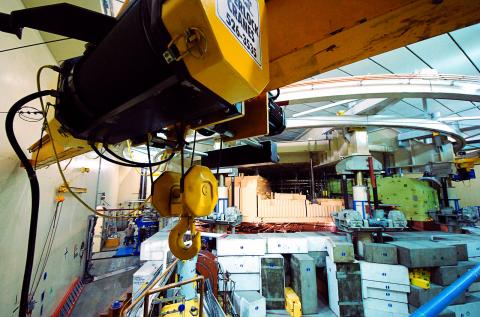
You know it's that time of the year again when the once energetic paperclips lie limp atop of our Meson Hall's dusty floors and tables. TRIUMF’s cyclotron is in operation everyday of the year except during its winter shutdown period between December and March when the cyclotron is turned off and major maintenance activities can be performed. A host of engineers, technicians, electricians, safety officers, operators, and beam physicists are involved to make for a successful shutdown.
The responsibilities of the cyclotron operators change during shutdown period, shifting from their usual monitoring of the cyclotron and the main injection beamline, including beam quality and radiation levels, to monitoring the progress of the shutdown, raising the cyclotron lid, and making the final decision on whether or not certain maintenance work can be performed in a controlled and safe way.
A month to six weeks before the actual shutdown period, the usual current of close to 240μA that runs through the cyclotron is dropped to a new current of mere nanoamperes. This allows the radiation inside the cyclotron tank to cool off for four to six weeks. During this cool off time, some low intensity beam users still have access to beam time to run their experiments. By lowering the radiation intensity, this time period also allows for many short-lived isotopes to be effectively ‘killed off’.
By the Christmas break, the cyclotron is officially shut down, which allows for the radiation levels in the cyclotron tank to drop even lower. The first safety survey will then be conducted before the cyclotron lid is raised to map out the radiation levels of the cyclotron vault. Sometime during January, the tank lid is raised and maintenance work on probes, extraction foils, and other devices in the tank begin. Since most of the radiation that comes from the cyclotron tank actually comes from the inside walls of the tank. Lead shields can be placed over the walls to cut down radiation levels by 20-30% once the cyclotron lid has been raised.
Raising the lid requires the coordination of operators and electrical and mechanical engineers to ensure that no problems arise during the process. The electrical components of the elevating system and mechanical components of the 24 elevating jacks must be working properly to allow for a synchronized elevation. The cyclotron lid will then be elevated by 48 inches over a period of about 45 minutes. All the 24 elevating jacks are connected to and feed back to the Master Controls Synchronous control system where they are monitored to make sure they are operating within its tolerance limits. If anything out of the ordinary occurs during this process, the jacks must be realigned and placed back in tolerance before further elevation can proceed. This process must be handled with the utmost care for if the lid were to warp or bend while being raised, severe damages that result would render the entire cyclotron useless.
Once the lid is raised, a second safety survey is conducted except this time the inside of the tank is also surveyed and a contour map of the gamma activity can be made. The lead shielding will then be lowered in place and a third safety survey will be conducted to scan the perimeter of the tank for another contour map. This map will be used to determine how much radiation a person will receive while working in a certain area of the tank, thus determining whether or not maintenance work is permitted.
The type of maintenance work performed involves the probes department of mechanical engineers and technicians to go into the tank to make needed repairs. There are two types of probes in operation, the diagnostic probe and the extraction probe. The extraction probe is responsible for beam extraction down various channels and therefore determines the energy of the extracted beam. Although the beam extracted from the cyclotron is a beam of protons, what first enters into the cyclotron tank and accelerated are actually negative hydrogen ions. The loosely attached electrons of the negative hydrogen ions are stripped away once they pass the carbon foil in these probes, leaving a beam of protons. Other maintenance types of work include repairs on the resonators, inflectors, deflectors, and correction plates in the tank.
Once all the maintenance work is complete the lid will then be lowered and the cyclotron is successively turned on over a course of about two weeks time. The major events to note are first the cyclotron main magnet being turned on, and then the same is done with its rapidly varying (radio frequency) electric field. Finally, within a few days, the beam can then be injected into the cyclotron and proton therapy and high-current operations can resume.
--by Elle Chau, TRIUMF's Outreach/Communications Assistant
Special thanks to John Kaminski for providing all of the technical information above.
Photo credit goes to Karry Ocean
